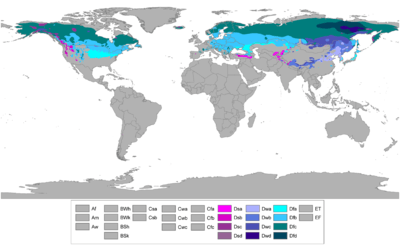Continental climate

Continental climates are climates with significant annual variation in temperature. They tend to occur in the middles of continents, where prevailing winds come from over land, and temperatures are not moderated by bodies of water such as oceans or seas. They mostly occur in the Northern Hemisphere in North America and Asia,[1] and at higher elevations in other parts of the world.
Often winter temperatures are cold enough to support a fixed period of snow each year. Precipitation tends to be moderate, occurring mostly in summer, although there are exceptions such as the upper east coast areas of North America which show an even distribution of precipitation: these are called humid continental climates. Only a few areas, in the mountains of the Pacific Northwest of North America and in Iran, northern Iraq, adjacent Turkey, Afghanistan, Pakistan, and Central Asia show a winter maximum in precipitation.
Temperatures
| Average temperature ranges | ||||||||
|---|---|---|---|---|---|---|---|---|
| season | day-time temperature range | night-time temperature range | ||||||
| Maximum | Minimum | Maximum | Minimum | |||||
| °F | °C | °F | °C | °F | °C | °F | °C | |
| summer | 90 | 32 | 70 | 21 | 65 | 18 | 50 | 10 |
| winter | 45 | 7 | 10 | −12 | 25 | −4 | −10 | −23 |
Spring and autumn
The timing of intermediate spring-like or autumn-like temperatures in this zone vary depending on latitude and/or elevation. For example, spring may arrive as soon as early March in the southern parts of this zone, or as late as May in the north. Annual precipitation in this zone is usually between 600 millimetres (24 in) to 1,200 millimetres (47 in), most of it in the form of snow during winter. It also has cold winters and warm summers.
Köppen climate classification
Most such areas fit Köppen classifications of Dfa, Dwa (cold winters, hot summers; "w" indicating very dry winters characteristic especially of China) or Dfb or Dwb (cold winters, warm summers, same distinction for winter dryness). Dry summer continental climates (Dsa and Dsb) exist in high altitude areas near Mediterranean climates.
Climatology
Continental climates exist where cold air masses infiltrate during the winter and warm air masses form in summer under conditions of high sun and long days. Places with continental climates are as a rule either far from any moderating effects of oceans (examples: Omaha, Nebraska, USA and Kazan, Russia) or are so situated that prevailing winds tend to head offshore (example: New York, USA). Such regions get quite warm in the summer, achieving temperatures characteristic of tropical climates but are much colder than any other climates of similar latitude in the winter.
Neighboring climates
These climates grade off toward subtropical climates equator-ward where winters are less severe and semiarid climates where precipitation becomes inadequate for tall-grass prairies. In Europe these climates may grade off into oceanic climates in which the influence of moderating air masses is more marked toward the west. The subarctic climate (Köppen: Dfc), with very cold, long and dry winters, but with at least one month above 10 °C (50 °F), might be considered a sub-type of the continental climate.
Examples
Example of areas of the world with continental climates are the eastern USA (Intermountain West, Midwestern, New England), eastern Canada, eastern China, Korea, northern Japan, most of Russia and Bosnia, parts of Norway, Sweden, inner parts of Spain and Turkey, parts of north and north-west of Iran, northern Iraq specifically Iraqi Kurdistan, Poland, Czech Republic, Austria, some parts of Azerbaijan, Germany, Slovakia, Slovenia, Hungary, Romania, Moldova, Ukraine, Armenia, Belarus, Lithuania, Latvia, Estonia and Finland. A continental climate can also be found in many valleys around mountains in the North Temperate Zone; such as the Alps (in France, Italy, Switzerland and Austria), the Pyrenees (in Spain, Andorra and France) or the Himalayas (in Afghanistan, Pakistan, India, China, Nepal, Burma and Bhutan).
Continental climates generally do not exist in the Southern Hemisphere due to the lack of broad land masses at middle latitudes, the southernmost parts of Africa, Australia and South America being too narrow in breadth to allow cold air masses to form. However, certain areas, such as New Zealand's South Island high country, experience conditions similar to those of continental climates. Antarctica lies completely outside the middle latitudes.
See also
References
- ↑ "Continental Climate". Encyclopedia of the Atmospheric Environment. Manchester Metropolitan University. Archived from the original on 2009-04-27.
External links
| Wikimedia Commons has media related to Continental climate. |
| ||||||||||||||||||||||